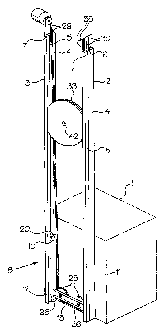Some of the information on this Web page has been provided by external sources. The Government of Canada is not responsible for the accuracy, reliability or currency of the information supplied by external sources. Users wishing to rely upon this information should consult directly with the source of the information. Content provided by external sources is not subject to official languages, privacy and accessibility requirements.
Any discrepancies in the text and image of the Claims and Abstract are due to differing posting times. Text of the Claims and Abstract are posted:
| (12) Patent: | (11) CA 2414748 |
|---|---|
| (54) English Title: | ELEVATOR COUNTERWEIGHT SYSTEM |
| (54) French Title: | SYSTEME DE CONTREPOIDS D'ASCENSEUR |
| Status: | Expired and beyond the Period of Reversal |
| (51) International Patent Classification (IPC): |
|
|---|---|
| (72) Inventors : |
|
| (73) Owners : |
|
| (71) Applicants : |
|
| (74) Agent: | CASSAN MACLEAN IP AGENCY INC. |
| (74) Associate agent: | |
| (45) Issued: | 2011-07-05 |
| (22) Filed Date: | 2002-12-19 |
| (41) Open to Public Inspection: | 2004-06-19 |
| Examination requested: | 2007-12-11 |
| Availability of licence: | N/A |
| Dedicated to the Public: | N/A |
| (25) Language of filing: | English |
| Patent Cooperation Treaty (PCT): | No |
|---|
| (30) Application Priority Data: | None |
|---|
A counterweight for an elevator is defined by a disc, which can be slidably mounted in tracks in an elevator shaft. Annular grooves in the periphery of the disc receive cables, which are anchored at the top of the shaft, and extend around pulleys on the rear of a car and a sheave driven by a reversible motor, whereby when the motor is actuated, the elevator moves vertically in one direction, while the counterweight rotates and moves vertically in the opposite direction.
Contrepoids d'ascenseur consistant en un disque monté de manière à glisser sur des rails dans une gaine d'ascenseur. Des gorges circulaires autour du disque reçoivent des câbles qui sont ancrés au sommet de la gaine, et de prolongent autour de poulie sur l'arrière d'une cabine, et un réa entraîné par un moteur réversible; lorsque le moteur est mis en marche, l'ascenseur se déplace verticalement dans une direction, alors que le contrepoids tourne et se déplace verticalement dans la direction opposée.
Note: Claims are shown in the official language in which they were submitted.
Note: Descriptions are shown in the official language in which they were submitted.

2024-08-01:As part of the Next Generation Patents (NGP) transition, the Canadian Patents Database (CPD) now contains a more detailed Event History, which replicates the Event Log of our new back-office solution.
Please note that "Inactive:" events refers to events no longer in use in our new back-office solution.
For a clearer understanding of the status of the application/patent presented on this page, the site Disclaimer , as well as the definitions for Patent , Event History , Maintenance Fee and Payment History should be consulted.
| Description | Date |
|---|---|
| Time Limit for Reversal Expired | 2022-06-21 |
| Letter Sent | 2021-12-20 |
| Letter Sent | 2021-06-21 |
| Letter Sent | 2020-12-21 |
| Common Representative Appointed | 2019-10-30 |
| Common Representative Appointed | 2019-10-30 |
| Appointment of Agent Requirements Determined Compliant | 2019-10-01 |
| Revocation of Agent Requirements Determined Compliant | 2019-10-01 |
| Inactive: Office letter | 2019-09-19 |
| Appointment of Agent Request | 2019-08-29 |
| Revocation of Agent Request | 2019-08-29 |
| Inactive: Late MF processed | 2017-06-05 |
| Letter Sent | 2016-12-19 |
| Grant by Issuance | 2011-07-05 |
| Inactive: Cover page published | 2011-07-04 |
| Notice of Allowance is Issued | 2011-05-03 |
| Inactive: Approved for allowance (AFA) | 2011-03-22 |
| Letter Sent | 2011-02-01 |
| Final Fee Paid and Application Reinstated | 2010-12-02 |
| Reinstatement Request Received | 2010-12-02 |
| Inactive: Final fee received | 2010-12-02 |
| Withdraw from Allowance | 2010-12-02 |
| Pre-grant | 2010-12-02 |
| Deemed Abandoned - Conditions for Grant Determined Not Compliant | 2010-10-14 |
| Letter Sent | 2010-04-14 |
| Notice of Allowance is Issued | 2010-04-14 |
| Notice of Allowance is Issued | 2010-04-14 |
| Inactive: Approved for allowance (AFA) | 2010-03-31 |
| Amendment Received - Voluntary Amendment | 2010-01-12 |
| Inactive: S.29 Rules - Examiner requisition | 2009-11-19 |
| Inactive: S.30(2) Rules - Examiner requisition | 2009-11-19 |
| Letter Sent | 2008-01-09 |
| All Requirements for Examination Determined Compliant | 2007-12-11 |
| Request for Examination Requirements Determined Compliant | 2007-12-11 |
| Request for Examination Received | 2007-12-11 |
| Inactive: IPC from MCD | 2006-03-12 |
| Application Published (Open to Public Inspection) | 2004-06-19 |
| Inactive: Cover page published | 2004-06-18 |
| Inactive: First IPC assigned | 2003-02-19 |
| Inactive: Filing certificate - No RFE (English) | 2003-02-04 |
| Application Received - Regular National | 2003-02-04 |
| Small Entity Declaration Determined Compliant | 2002-12-19 |
| Abandonment Date | Reason | Reinstatement Date |
|---|---|---|
| 2010-12-02 | ||
| 2010-10-14 |
The last payment was received on 2010-12-02
Note : If the full payment has not been received on or before the date indicated, a further fee may be required which may be one of the following
Patent fees are adjusted on the 1st of January every year. The amounts above are the current amounts if received by December 31 of the current year.
Please refer to the CIPO
Patent Fees
web page to see all current fee amounts.
Note: Records showing the ownership history in alphabetical order.
| Current Owners on Record |
|---|
| HAROLD H. HAYNES |
| Past Owners on Record |
|---|
| None |